Mexico
| |
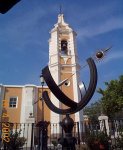 |
Colima |
Colima |
Mexico |
Equatorial Dial |
Dial 477 |
| A bright bronze equatorial sundial with a stainless steel equatorial band. The gnomon has an analemma for the correction of time and a colorful sunburst near the northern end of the rod. |
| |
| |
 |
Corregidora |
Queretaro |
Mexico |
Gnomonic or Projection Dial |
Dial 768 |
| A projection (or, "negative") dial using the south-facing wall and floor of the "Cosmic Room" of a "casa de campo" private cottage. The tile roof over this room contains several skylights with slits for projecting a beam of sunlight onto the wall and one skylight with a small hole to project a dot of sunlight onto the room floor. |
| |
| |
|
Cuencame |
Durango |
Mexico |
Vertical Dial |
Dial 489 |
| This vertical dial is 2m tall by 1.2 m wide and sits atop a quarried column nearly 7 m high. The gnomon on each face is approximately 60 cm long, and 16-19 mm in diameter. Each face has Roman numerals to indicate apparent solar time from 6am to 6pm. Alpha and Omega Greek letters. A carved cross at the twelve hour line. Inscribed "1904" |
| |
| |
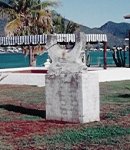 |
Guaymas |
Sonora |
Mexico |
Equatorial Dial |
Dial 388 |
| Dial is of stone, carved in a thick semi-circle ring about 200 degrees in extent. Dial is 36 inches in diameter and 10 inches thick. The inner rim of the dial is a "vee" shape. The gnomon is an iron rod protruding from the equatorial ring at the 12-hour mark, and at the center of the ring turns at a right angle to align to the north pole. The massive stone dial is set on a masonry block pedestal 40x40x20 inches. The pedestal is neither level nor cardinal. |
| |
| |
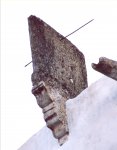 |
Merida |
Yucatan |
Mexico |
Vertical Dial |
Dial 537 |
| This is south-facing vertical or scratch dial with horizontal gnomon and located on the roof at the front of an early church monastery cloister. The stone dial is approximately 3 feet square. The north face is similarly inscribed. This is among the earliest sundials in North America. |
| |
| |
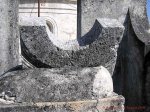 |
Merida |
Yucatan |
Mexico |
Equatorial Dial |
Dial 538 |
| Generally identified as an equatorial, this stone cylindrical cavity dial uses the extremities of the semicircular dial plate as two independent styles. The dial face is marked with six equally-spaced hour lines with minor subdivisions. The east style casts the 6 AM to noon shadow while the west style casts the noon to 6 PM shadow. No construction date is give but is likely 18th century or earlier. |
| |
| |
 |
Mexico City |
Distrito Federal |
Mexico |
Horizontal Dial |
Dial 453 |
| A triangular based horizontal dial with a triangular moat. The outer triangular sides are approximately 12 feet (4 meters). The dial and moat are built of concrete, with an aluminum or sheet metal gnomon about 150 cm. On the dial are metal pyramids to indicate hours. The sundial was donated by the Tecnologico de Monterrey University. |
| |
| |
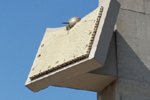 |
Mexico City |
México |
Mexico |
Vertical Dial |
Dial 1001 |
| This is a south facing reclining vertical sundial made of stone about one and a half meter square. The dial's concrete mount adjusts the dial to true south even though the carillon tower is not N-S aligned. Hour lines and Roman numbers on the dial go from 7am to 5pm. Monthly declination lines show the date as well as the solstices and equinox. A simple rod gnomon exits a gold ball at the top of the dial. The dial itself is well above eye level and hard to read. The other end of the carillon tower has an Aztec calendar. |
| |
| |
|
Monterrey |
Nuevo Leon |
Mexico |
Equatorial Dial |
Dial 488 |
| This equatorial dial is just over 3 m in size, made of iron. Along the equatorial band are twelve Roman numerals to indicate apparent solar time and twelve Arabic numerals to indicate standard time. The outside of the equatorial band has zodiac constellations. There are also solstice and equinox discs at the gnomon. There is a plaque for the equation of time and an explanation of time corrections next to the sundial. The dial sits on a 1 m high stone base. |
| |
| |
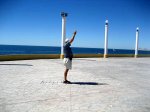 |
Puerto Penasco |
Sonora |
Mexico |
Analemmatic Dial |
Dial 600 |
| A concrete analemmatic dial set in the El Camaronero Plaza on the Sea of Cortez. The dial is 20 feet E-W across the hour markers. The dateline displays the 1st, 10th and 20th of each month. Dial includes 34 minutes longitude correction. Instructions in Spanish and English are displayed nearby. |
| |
| |
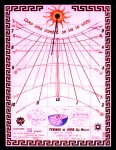 |
Tenango de Doria |
Hidalgo |
Mexico |
Vertical Dial |
Dial 459 |
| A very striking vertical reclining dial 85 x 115 cm created from hand painted tiles, each individually fired in a kiln and assembled at Tenango de Doria by David Canyedo. In addition to hour lines, the dial includes declination lines for the solstices and equinox. The dial includes constellation maps of both the northern and southern hemispheres, a celestial sphere, and rose of winds (compass). The artistry also includes NAHUI OLLIN (the fifth sun which is the era we are living in according to the Aztecs). The dial has an equation of time that allows conversion from local solar time to standard time. The dial was designed to arouse interest of high school students in astronomy. |
| |
| |
 |
Torre |
Coahuila |
Mexico |
Analemmatic Dial |
Dial 509 |
| An analemmatic dial with major axis of 18 feet built of many different types of stone from the Torre?n Jard?n area, including white and red marble, travertine, yellow and black flagstone, and limestone. Insets of gray stone hold the hour markers from 5am to 7pm. The finished dial has been set in desert plants, native to the region, including: Candelilla, Gobernadora, Lechuguilla, Sangre de drago, Huevo de toro, Biznaga, Pitaya, Corona de espinas, Nopal rastrero, and Cardenche. These are all protected desert species. The dial has a compass rose and six disk-shaped maps at the east and west sides to show the course of sunrise/sunset across the Mexican Republic on the solstices and equinox. |
| |
| |
|
Torreon |
Coahuila |
Mexico |
Vertical Dial |
Dial 487 |
| This is a stone cube 3.5 m high with four vertical dials. Each dial face is about 2.2 m high by 1.25 m wide The South and North faces have Arabic numerals to indicate solar time from 6am to 18hrs, with marks every 15 minutes. The East face has numerals from 6am to 12pm and the West face complements from 12pm to 18hrs. These faces have half hour marks. The South face has seven declination lines, constellation dates, analemma line, zodiac symbols, and equinoctial and solstice lines. A curve to indicate light and shadow hours all the year is on each face. A square base on quarry. At the north-east corner are the carved names of the designer Miguel Bertran de Quintana and builder Cirilo Nunez.
Note: because of the sundial size and latitude, it was necessary to extend the four vertical faces of the sundial into the horizontal plane to indicate the summer solstice line and 11:30 and noon hours of summer. |
| |
| |
 |
Villahermosa |
Tabasco |
Mexico |
Compound Dial |
Dial 380 |
| A "Gnomonicon", or multi-indication dial, made of concrete, aluminum, brass and copper. The dial stands approximately 5 feet high and has multiple solar time dials in many orientations plus a flat equatorial, a concave equatorial, a revolving equatorial and a rare spherical dial. Also a solar calendar and representations of the ecliptic and the zodiac. |
| |